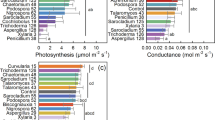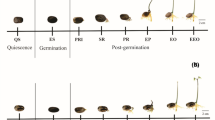Abstract
Key message
Carbohydrate differences in offspring as a consequence of maternal effects explain transgenerational tree-pathogen interactions.
Abstract
The expression of disease is increasingly recognised as being influenced by maternal effects, given that environmental conditions experienced by mother trees affect tolerance in offspring. It is hypothesised that plant carbohydrates could mediate transgenerational tree-pathogen interactions. The carbohydrate content of Pinus pinaster seedlings obtained from two contrasting maternal environments was studied and seedlings from the two environments were challenged with Fusarium circinatum. The representative mid-infrared spectra of samples in the range of the carbohydrates diagnosed higher proportion of methylesterified pectic polysaccharides and lower proportion of nonesterified pectic polysaccharides for inoculated than for control seedlings. Total carbohydrate content of seedlings from the unfavourable environment did not differ much from total carbohydrate content of seedlings from the favourable maternal environment. However, glucose was 13 % higher and uronic acids 11 % lower in seedlings from the favourable environment after inoculation in comparison to seedlings from the unfavourable maternal environment which had their carbohydrate contents unaltered after inoculation. It is concluded that plant carbohydrates mediate transgenerational tree-pathogen interactions.



Similar content being viewed by others
References
Agustí-Brisach C, Pérez-Sierra A, Armengol J, García-Jiménez J, Berbegal M (2012) Efficacy of hot water treatment to reduce the incidence of Fusarium circinatum on Pinus radiata seeds. Forestry 85:629–635
Allwood JW, Ellis DI, Heald JK, Goodacre R, Mur LA (2006) Metabolomic approaches reveal that phosphatidic and phosphatidyl glycerol phospholipids are major discriminatory non-polar metabolites in responses by Brachypodium distachyon to challenge by Magnaporthe grisea. Plant J 46:351–368
Allwood JW, Ellis DI, Goodacre R (2008) Metabolomic technologies and their application to the study of plants and plant–host interactions. Physiol Plant 132:117–135
Avigad G, Dey PM (1997) Carbohydrate metabolism: storage carbohydrates. In: Dey PM, Harborne JB (eds) Plant Biochemistry. Academic Press, London, pp 143–204
Azevedo H, Conde C, Gerós H, Tavares RM (2006) The non-host pathogen Botrytis cinerea enhances glucose transport in Pinus pinaster suspension-cultured cells. Plant Cell Physiol 47:290–298
Barros AS, Mafra I, Ferreira D, Cardoso S, Reis A, Lopes da Silva JA, Delgadillo I, Rutledge DN, Coimbra MA (2002) Determination of the degree of methylesterification of pectic polysaccharides by FT-IR using an outer product PLS1 regression. Carbohydr Polym 50:85–94
Berger S, Sinha AK, Roitsch T (2007) Plant physiology meets phytopathology: plant primary metabolism and plant-pathogen interactions. J Exp Bot 58:4019–4026
Bishop DL, Chatterton NJ, Harrison PA, Hatfield RD (2002) Changes in carbohydrate coordinated partitioning and cell wall remodeling with stress-induced pathogenesis in wheat sheaths. Physiol Mol Plant Pathol 61:53–63
Cendán C, Sampedro L, Zas R (2013) The maternal environment determines the timing of germination in Pinus pinaster. Environ Exp Bot 94:66–72
Coimbra MA, Delgadillo I, Waldron KW, Selvendran RR (1996) Isolation and analysis of cell wall polymers from olive pulp. In: Linskens H, Jackson J (eds) Modern methods of plant analysis-Plant cell wall analysis. Springer, Berlin, pp 19–44
Donohue K (2009) Completing the cycle: maternal effects as the missing link in plant life histories. Philos Trans R Soc B Biol Sci 364:1059–1074
Filippov MP (1992) Practical infrared spectroscopy of pectic substances. Food Hydrocoll 6:115–142
García-Serna I (2011) Diplodia pinea (Desm.) Kickx y Fusarium circinatum Nirenberg & O’Donnell, principales hongos de chancro de las masas forestales de Pinus radiata D. Don en el País Vasco. Doctoral thesis, University of País Vasco
Herman JJ, Sultan SE (2011) Adaptive transgenerational plasticity in plants: case studies, mechanisms, and implications for natural populations. Front Plant Sci 2:1–10
Herms DA, Mattson WJ (1992) The dilemma of plants: to grow or defend. Q Rev Biol 67:283–335
Keunen E, Peshev D, Vangronsveld J, Van den Ende W, Cuypers A (2013) Plant sugars are crucial players in the oxidative challenge during abiotic stress. Extending the traditional concept. Plant Cell Environ 36:1242–1255
Kozlowski T (1992) Carbohydrate sources and sinks in woody plants. Bot Rev 58:107–222
Landeras E, García P, Fernández Y, Braña M, Fernández-Alonso O, Méndez-Lodos S, Pérez-Sierra A, León M, Abad-Campos P, Berbegal R, Beltrán R, García-Jiménez J, Armengol J (2005) Outbreak of pitch canker caused by Fusarium circinatum on Pinus spp. in northern Spain. Plant Dis 89:1015
Martín JA, Solla A, Coimbra MA, Gil L (2005a) Metabolic distinction of Ulmus minor xylem tissues after inoculation with Ophiostoma novo-ulmi. Phytochemistry 66:2458–2467
Martín JA, Solla A, Woodward S, Gil L (2005b) Fourier transform-infrared spectroscopy as a new method for evaluating host resistance in the Dutch elm disease complex. Tree Physiol 25:1331–1338
Martín JA, Solla A, Coimbra MA, Gil L (2008) Metabolic fingerprinting allows discrimination between Ulmus pumila and U. minor, and between U. minor clones of different susceptibility to Dutch elm disease. For Pathol 38:244–256
Morkunas I, Kozłowska M, Ratajczak L, Marczak Ł (2007) Role of sucrose in the development of Fusarium wilt in lupine embryo axes. Physiol Mol Plant Pathol 70:25–37
Morkunas I, Stobiecki M, Marczak Ł, Stachowiak J, Narożna D, Remlein-Starosta D (2010) Changes in carbohydrate and isoflavonoid metabolism in yellow lupine in response to infection by Fusarium oxysporum during the stages of seed germination and early seedling growth. Physiol Mol Plant Pathol 75:46–55
Oliveira H, Barros AS, Delgadillo I, Coimbra MA, Santos C (2009) Effects of fungus inoculation and salt stress on physiology and biochemistry of in vitro grapevines: emphasis on sugar composition changes by FT-IR analyses. Environ Exp Bot 65:1–10
Oßwald W, Fleischmann F, Treutter D (2012) Host–parasite interactions and trade-offs between growth- and defence-related metabolism under changing environments. In: Matyssek R, Schnyder H, Oßwald W, Ernst D, Munch JC, Pretzsch H (eds) Growth and defence in plants. Springer, Berlin, pp 53–83
Pristov JB, Mitrović A, Spasojević I (2011) A comparative study of antioxidative activities of cell-wall polysaccharides. Carbohydr Res 346:2255–2259
Schmale DG, Gordon TR (2003) Variation in susceptibility to pitch canker disease, caused by Fusarium circinatum, in native stands of Pinus murcicata. Plant Pathol 52:720–725
Selvendran RR, O’Neill MA (1987) Isolation and analysis of cell walls from plant material. In: Glick D (ed) Methods of biochemical analysis. Wiley, New York, pp 25–153
Shibuya N, Minami E (2001) Oligosaccharide signalling for defence responses in plant. Physiol Mol Plant Pathol 59:223–233
Truernit E, Schmid J, Epple P, Illig J, Sauer N (1996) The sink-specific and stress-regulated Arabidopsis STP4 gene: enhanced expression of a gene encoding a monosaccharide transporter by wounding, elicitors, and pathogen challenge. Plant Cell 8:2169–2182
Vivas M, Martín JA, Gil L, Solla A (2012a) Evaluating methyl jasmonate for induction of resistance to Fusarium oxysporum, F. circinatum and Ophiostoma novo-ulmi. For Syst 21:289–299
Vivas M, Zas R, Solla A (2012b) Screening of Maritime pine (Pinus pinaster) for resistance to Fusarium circinatum, the causal agent of Pitch Canker disease. Forestry 25:185–192
Vivas M, Zas R, Sampedro L, Solla A (2013) Environmental maternal effects mediate the resistance of Maritime pine to biotic stress. PLoS One 8:e70148
Vorwerk S, Somerville S, Somerville C (2004) The role of plant cell wall polysaccharide composition in disease resistance. Trends Plant Sci 9:203–209
Waring RH (1987) Characteristics of trees predisposed to die. Bioscience 37:569–574
Wingfield MJ, Hammerbacher A, Ganley RJ, Steenkamp ET, Gordon TR, Wingfield BD, Coutinho TA (2008) Pitch canker caused by Fusarium circinatum—a growing threat to pine plantations and forests worldwide. Australas Plant Pathol 37:319–334
Acknowledgments
We thank Delicias Espada, Enrique Juárez and Andrea Pérez for technical assistance during the greenhouse experiment; Dr. Ana Pérez-Sierra for molecular identification of the fungus; César Cendán, Rocío Campano and Luz Pato for cone sampling and processing and Dr. Luis Sampedro and Dr. Rafael Zas for their technical advice and for providing us with the seed material. We also thank the Galician forestry authorities (Direccion Xeral de Montes-Xunta de Galicia) for the facilities provided at the seed orchards. This study was funded by Instituto Nacional de Investigación Agraria (RTA2007-100) and Ministerio de Ciencia e Innovación (MCI) (AGL2010-18724). Thanks are due to Fundação para a Ciência e a Tecnologia (FCT, Portugal), European Union, QREN, FEDER and COMPETE for funding the QOPNA research unit. María Vivas and Claudia Nunes received grants from the FPU-PREDOC programme of MCI and from the FCT (SFRH/BPD/46584/2008), respectively.
Conflict of interest
The authors declare that they have no conflict of interest.
Author information
Authors and Affiliations
Corresponding author
Additional information
Communicated by W. Osswald.
Rights and permissions
About this article
Cite this article
Vivas, M., Nunes, C., Coimbra, M.A. et al. Maternal effects and carbohydrate changes of Pinus pinaster after inoculation with Fusarium circinatum . Trees 28, 373–379 (2014). https://doi.org/10.1007/s00468-013-0955-0
Received:
Revised:
Accepted:
Published:
Issue Date:
DOI: https://doi.org/10.1007/s00468-013-0955-0




